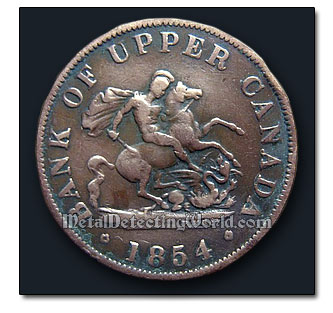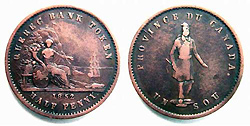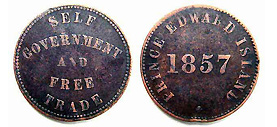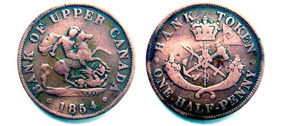Pre-Confederation Canada Bank Tokens
Numismatic, Historical Information and Images

Under the British rule, Pre-Confederation tokens, Bouquet Sous, Habitant Sous, half penny and penny tokens, served as coins until 1867 when Confederation formed the Dominion of Canada which started issuing decimal coins in 1870. About the beginning of the 19th century, the balance of trade and valuation of the coins of the various minting countries (principal among them the Spanish milled dollar) caused a continuing export of coins from Canada.
This resulted in a lack of coinage for small common transactions. To counteract this, extensive quantities of low-denomination tokens were imported from England by merchants. By issuing tokens and encouraging trade at their establishments, they made profits on the cost of the tokens themselves.
In 1837, Hard Times brought discontent. The French had never been happy with English rule in Lower Canada, the Lawrentian plain to about Lake Erie. Upper Canada, the lands along Great Lakes, was 80% American or mostly non-English. A small number of powerful families controlled Canada, much to the dislike of the hardy pioneering types. Rebellions broke out in both Upper and Lower Canada. They were crushed.
The government authorized four banks, the Bank of Montreal, the Quebec Bank, the City Bank and La Banque du Peuple, to issue copper pennies and halfpennies with the arms of Montréal on one side and a standing habitant on the other. These coins arrived in Canada just as the Rebellion of 1837 began and were issued in 1838.

When Upper and Lower Canada were reunited into the Province of Canada in 1841, the Bank of Montreal was allowed to coin copper; pennies and halfpennies appeared in 1842. Halfpennies were issued again in 1844. After 1849 the Bank Of Upper Canada received the right to coin copper and large issues of pennies and halfpennies appeared in 1850, 1852, 1854 and 1857. The Quebec Bank was allowed to issue pennies and halfpennies in 1852.

Under the Province of Canada only bank tokens were issued and no merchant or private tokens were allowed. No Province of Canada tokens were issued after 1857, as the British government introduced 1, 5, 10 and 20 cent pieces in 1858 quickly followed by issuances from provinces of Nova Scotia and New Brunswick (1861), Newfoundland (1865), and Prince Edward Island (1871).
The Pre-Confederation tokens were struck at the folloing mints: The Royal Mint, Boulton and Watt, Ralph Heaton and Co., Thomas Halliday, William Mossop, Wright and Bale, Belleville Mint (New Jersey), Jean Marie Arnault, and various Blacksmith Mints.

Make a Donation
Please help me stay afloat, afford more metal detecting trips with field-tests and experiments to create more informative articles, useful tutorials and helpful guides for detectorists, and maintain this website - the most informative hobby resource on the web! Since I do not have any steady income, any donation matters to me a lot! Thank you kindly!
Clicking on the donate button will take you to a donation page powered by Donorbox and dedicated to my website (MetalDetectingWorld.com). The donation page is PCI-compliant, secured by SSL/TLS, and has a simple form to fill out. Donorbox does not store any card or bank data. Credit card information is encrypted and tokenized by the Stripe payment processor.
This website would not exist without the advertisements we display and your kind donations. If you are unable to support us by viewing our advertisements, please consider making a Donation to ensure the future of this website. By helping me keep this website alive and growing, you will sure help many detectorists around the world as well!
ANNOUNCEMENT:
In January of 2020, I started a one-time fund-raising campaign in attempt to accumulate enough money to buy a simple but reliable 4x4 vehicle. My old 4x4 car (made in 1995) had faithfully served me for 10 years before it eventually went beyond repair last October. Without a 4WD, I will not be able to get to my hunt sites and test-plots hidden in the remote wooded areas inaccessible by a regular car.
Unlucky for me, those sites are the only locations available and suitable for my field-work which results in informative articles you can find on this website. For the past 10 years, my usual field-work has consisted of field-testing the latest metal detectors and accessories, experimenting with some of them, and devising new effective search methods that meet the requirements of the new metal detecting reality.
Before my car died, I managed to finish a couple of interesting detector-testing projects which will be covered in my upcoming articles. But other equally important projects that I was working on were not completed and had to be postponed until the Spring 2020. I hope that this fund-raising campaign will help me get a decent 4x4 by then so that I will be able to resume my work and to write more new articles, tutorials and guides based on data gathered through testing and experimentation.
If you find my website useful and would like it to provide more essential info for you and other detectorists worldwide, please consider chipping in $5, $20, $50 or whatever you can afford to keep MetalDetectingWorld.com growing in 2020. I promise you, it will be money well spent. Thank you.
Donate- Please help me promote this article:
If you would like to follow me on Twitter, please press a button:
I have my profile page on
where you can share your thoughts on this section, ask me a question, or place a friend request.I also have my profile pages on Pinterest, LinkedIn, Tumblr, Reddit and Delicious
and my "Metal Detecting World" page on Twitter, Pinterest and Tumblr